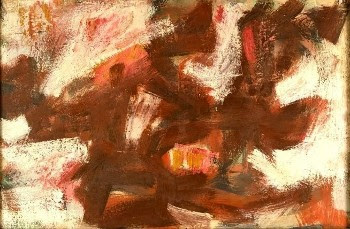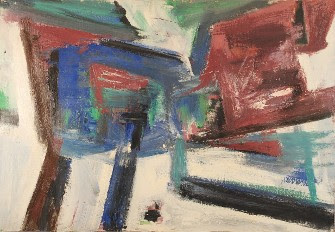Melville Price was born in Kingston, NY in 1920. Working in New York City in the 1940s he became one of the youngest members of the Abstract Expressionist movement. Early influences were Joseph Stella who became a mentor in 1939 and Franz Kline with whom he shared a close, long friendship. Price experimented with Cubist and Surrealist imagery.
In 1942 he moved to Woodstock, NY. There his paintings grew more modern & abstract.Friendships were established with Bradley Walker Tomlin & Raoul Hague. His breakthrough came in 1948 with the "Maze Series," a body of original, complex, organically twisting abstractions. Price gained critical notice with exhibitions in New York at Peridot Gallery, Charles Egan Gallery as well as Hugo, Bodley and Iolas Galleries.
In 1951 he was included in the 9th St. Show at Stable Gallery and was invited to join the "Club". In 1951 be began commuting to Philadelphia where painter Leonard Nelson helped him secure a teaching job at the Museum School. He eventually moved there becoming a full-time faculty member. In Philadelphia he exhibited at Dubin and Hendler Galleries. In 1955 he & his wife moved to New Hope PA on the Delaware River where he began "The New Hope Series, colorful, large expressionist canvases that were a departure from the Maze series. In 1958 Price accepted a job teaching at the University of Alabama. There he began his best know series of oils that he named "Black Warrior," based on the Alabama River of the same name.
He commuted back to New Jersey to paint while on a teaching sabbatical from the University. He followed the "Black Warrior" series with a group of collaged Pop image-based canvases incorporating words, numbers and fragmented elements of advertising. In 1962 Price began showing again in New York at Gallery Mayer. After his death in 1970 Price was honored with retrospective exhibitions at the Speed Museum in Louisville, KY and the Corcoran Gallery in Washington, DC. He is represented in many private and public collections including the Art Institute of Chicago, the Baltimore Museum of Art, the Corcoran Museum of Art, the Greenville County Museum of Art, the Los Angeles Museum County Museum of Art, the Milwaukee Art Museum, the National Museum of American Art, the Smart Museum at the University of Chicago and the Speed Museum.



